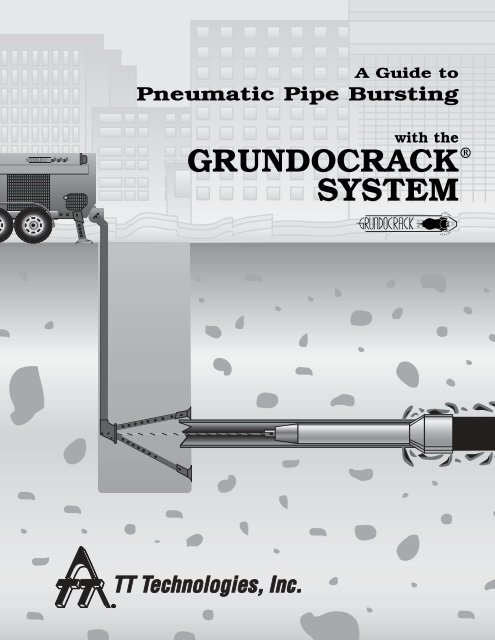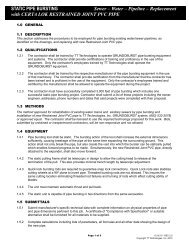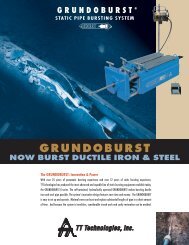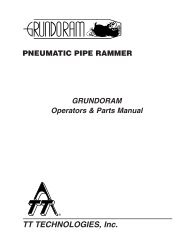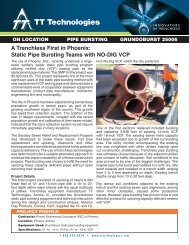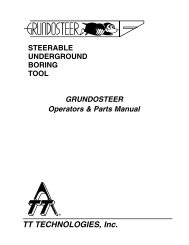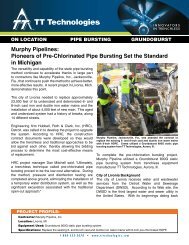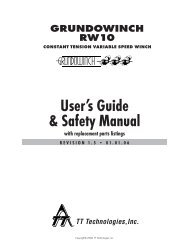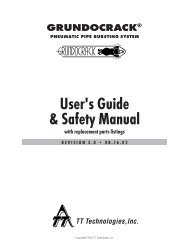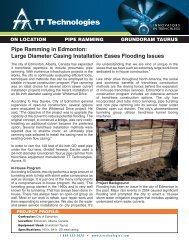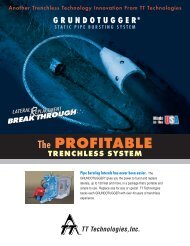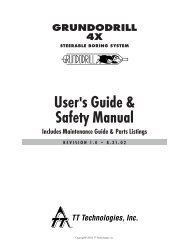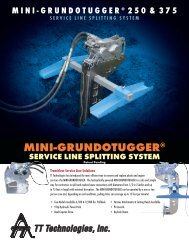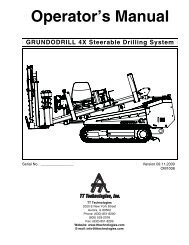Pneumatic Guide to Pipe Bursting - TT Technologies Inc.
Pneumatic Guide to Pipe Bursting - TT Technologies Inc.
Pneumatic Guide to Pipe Bursting - TT Technologies Inc.
You also want an ePaper? Increase the reach of your titles
YUMPU automatically turns print PDFs into web optimized ePapers that Google loves.
A <strong>Guide</strong> <strong>to</strong><br />
<strong>Pneumatic</strong> <strong>Pipe</strong> <strong>Bursting</strong><br />
with the<br />
®<br />
GRUNDOCRACK<br />
SYSTEM
Table of Contents<br />
1) Foreword ....................................................................................................................4<br />
2) Company Background ...............................................................................................5<br />
3) <strong>Pipe</strong> <strong>Bursting</strong> His<strong>to</strong>ry ................................................................................................6<br />
4) GRUNDOCRACK Concept .......................................................................................7<br />
5) Project Considerations ........................................................................................ 8-13<br />
6) GRUNDOCRACK Equipment Specifications................................................... 14-15<br />
7) Special Applications .......................................................................................... 16-19<br />
8) Ben<strong>to</strong>nite Specifications .................................................................................... 20-21<br />
9) GRUNDOWINCH Specifications ...........................................................................22<br />
2020 E. New York Street • Aurora, IL 60502<br />
800-533-2078 • 630-851-8200 • FAX 630-851-8299 • Internet http://www.tttechnologies.com
For over 35 years <strong>TT</strong> <strong>Technologies</strong> has lead the way<br />
for trenchless replacement systems beginning with<br />
pneumatic piercing <strong>to</strong>ols. Today, after over 200<br />
patents worldwide, <strong>TT</strong>’s pneumatic <strong>to</strong>ols are used<br />
in trenchless applications ranging from pipe pulling,<br />
pipe ramming, sliplining, directional drilling, and<br />
pipe bursting, both mainline and laterals.<br />
While “pipe bursting” can be a generic term, 90%<br />
of the bursts worldwide are accomplished using<br />
pneumatic <strong>to</strong>ols, the majority use the<br />
<strong>TT</strong> GRUNDOCRACK ® equipment.<br />
<strong>TT</strong> <strong>Technologies</strong>, <strong>Inc</strong>., the proud leader in the<br />
trenchless industry, makes safety priority number<br />
one each day. For everyone's safety read the<br />
opera<strong>to</strong>rs manual carefully and exercise caution<br />
while using the GRUNDOCRACK pipe bursting<br />
system. Personal injury or death could result from<br />
improper use of the system. Have existing buried<br />
utilities located prior <strong>to</strong> digging, CALL BEFORE<br />
YOU DIG (ONE-CALL 1-888-258-0808).<br />
Safety is always a high priority when it<br />
comes <strong>to</strong> <strong>TT</strong> <strong>Technologies</strong> equipment<br />
and we always appreciate the feedback<br />
we receive. If additional<br />
manuals or<br />
safety decals<br />
are required,<br />
please call<br />
1-800-533-2078.<br />
GRUNDOWINCH<br />
4
Active from the start of the “trenchless revolution,”<br />
<strong>TT</strong> <strong>Technologies</strong>, <strong>Inc</strong>., continues <strong>to</strong> be a leader<br />
and innova<strong>to</strong>r in the field of no-dig technology.<br />
Beginning in the 1970’s with a small staff<br />
promoting a limited line of pneumatic piercing<br />
<strong>to</strong>ols, <strong>TT</strong> has since exploded on the market as<br />
the source for a variety of trenchless <strong>to</strong>ols<br />
and accessories.<br />
This success is attributed <strong>to</strong> field proven product,<br />
and <strong>to</strong> the <strong>TT</strong> people. <strong>TT</strong> <strong>Technologies</strong> has<br />
assembled a team of highly motivated professionals<br />
who are dedicated <strong>to</strong> cus<strong>to</strong>mer satisfaction. And<br />
this process extends far beyond the sale. <strong>TT</strong> staff<br />
assist with proper product training, as well as<br />
lending technical expertise at cus<strong>to</strong>mer job sites<br />
throughout North America.<br />
Now headquartered in expanded facilities,<br />
<strong>TT</strong> <strong>Technologies</strong> is poised <strong>to</strong> provide the right<br />
<strong>to</strong>ols and technologies for trenchless contrac<strong>to</strong>rs<br />
well in<strong>to</strong> the 21st century, and beyond.<br />
Real job situations involving<br />
<strong>TT</strong> <strong>Technologies</strong>’<br />
GRUNDOCRACK <strong>to</strong>ols have<br />
been featured in numerous<br />
industry publications.<br />
Air Compressor<br />
5
<strong>Pipe</strong> bursting allows the replacement of cast iron,<br />
clay, concrete, and other fracturable pipes with<br />
a new line of the same, or larger size with a<br />
minimum, and in some cases, no excavation and<br />
disturbance <strong>to</strong> the environment.<br />
<strong>Pipe</strong> bursting can achieve significant savings over<br />
traditional “open cut” excavations.<br />
Free literature on GRUNDOCRACK<br />
<strong>to</strong>ols can be obtained by contacting<br />
<strong>TT</strong> <strong>Technologies</strong>, <strong>Inc</strong>.<br />
GRUNDOWINCH<br />
6
The GRUNDOCRACK system is effectively used<br />
where existing pipes have failed beyond the<br />
possibility of point repairs. It is also ideal for<br />
use where sliplining or “cured in place” is not an<br />
option due <strong>to</strong> reduction in pipe sizes.<br />
The term “fracturable” applies <strong>to</strong> host pipe<br />
materials such as cast iron, clay, non-reinforced<br />
and reinforced concrete, ABS, and some plastics.<br />
The percussive action of the GRUNDOCRACK<br />
<strong>to</strong>ol, combined with the expander forcing the<br />
fragments out in<strong>to</strong> the surrounding soil provides<br />
the space needed for the placement of the new<br />
pipe. It is this expansive action that allows for the<br />
new pipe upsizing. This soil expansion and the<br />
percussive action of the <strong>to</strong>ol also reduces stress on<br />
the new product pipe.<br />
The twin capstan, dual speed, constant tension<br />
GRUNDOWINCH is essential <strong>to</strong> the bursting<br />
process as it provides friction for the pneumatic<br />
<strong>to</strong>ol, and guides the <strong>to</strong>ol through the host pipe.<br />
The winch is not used <strong>to</strong> “force” the <strong>to</strong>ol, as a<br />
minimal pull is needed <strong>to</strong> allow the percussive<br />
action of the hammer <strong>to</strong> do the bursting. In<br />
addition, the winch “pull” is used <strong>to</strong> provide<br />
tension on the product pipe.<br />
Front Expander<br />
<strong>Guide</strong> Head<br />
Rear Expander<br />
Air Compressor<br />
7
Host <strong>Pipe</strong> Materials<br />
1. Concrete, Reinforced Concrete—Good bursting<br />
potential. Steel welded wire mesh and thickly encased<br />
pipes may cause concern and may require special<br />
guide head design.<br />
2. Clay—Good bursting potential. <strong>Pipe</strong>s with PVC<br />
joints need special applications <strong>to</strong>ols.<br />
3. Cast Iron—Good bursting potential. Special<br />
applications <strong>to</strong>ols and protection of the winch cable<br />
must be considered.<br />
4. PVC, ABS Plastic—Some bursting potential.<br />
Special cutting blades are necessary, length of runs<br />
may be reduced.<br />
5. Transite—Good bursting potential.<br />
6. Asbes<strong>to</strong>s - Cement <strong>Pipe</strong>—Good bursting potential.<br />
7. Truss pipe - a combination of plastic with a<br />
concrete honeycomb reinforcement. Good bursting<br />
potential.<br />
Host <strong>Pipe</strong> Depth and Profile<br />
1. May effect both winch & pneumatic <strong>to</strong>ol selection.<br />
2. May effect length of entrance & exit pit requirements.<br />
GRUNDOWINCH<br />
3. Special cutting attachments for repair joints, if<br />
present.<br />
4. May effect length of possible bursting runs - larger<br />
diameter pipe may require shorter burst lengths.<br />
8
Host <strong>Pipe</strong> Depth and Profile<br />
1. Expansion of surrounding soil is affected by depth<br />
of host pipe. Using this guide for minimum depth<br />
cover (10x the <strong>to</strong>tal upsize) (See example on the right).<br />
2. Water table considerations vary with depth -<br />
working below the water table may require<br />
dewatering procedures such as "well pointing" - and<br />
in some cases an alternative burst system such as the<br />
Grundoburst static system may be more efficient.<br />
Example:<br />
An existing 8-inch cast iron pipe needs <strong>to</strong> be replaced with a new<br />
8-inch line with a carrying capacity of an 8-inch pipe. Working<br />
pressure is 150 PSI. The pipe is approximately 4 feet deep. Based<br />
on the working pressure, SDR 11 (165 PSI) is selected. The inside<br />
diameter (ID) of 8-inch pipe is 6.963 inches. A 10-inch SDR 11 pipe<br />
with an ID of 8.679 inches is needed <strong>to</strong> supply the 8-inch carrying<br />
capacity. The outside diameter (OD) of the 10-inch pipe is 10.75.<br />
Therefore, the upsize is from 8-inch ID Cast Iron <strong>to</strong> 10.75-inch OD<br />
HDPE, an increase 2.75 inches.<br />
The manufacturer’s <strong>to</strong>ol recommendation for this particular burst<br />
is an 8.5-inch diameter pneumatic bursting <strong>to</strong>ol, equipped with a<br />
13.8-inch OD rear expander. With the rear expander, the <strong>to</strong>tal upsize<br />
becomes 8-inch ID <strong>to</strong> 13.8-inch OD, an increase of 5.8 inches. Using<br />
the guide for minimum depth cover (10x the <strong>to</strong>tal upsize), based on<br />
5.8 inches, the minimum pipe depth requirement for bursting in this<br />
scenario would be approximately 58-inches (10 x 5.8-inches). This<br />
depth will prevent any heaving of the ground and pavement caused<br />
by soil displacement. In this situation, the existing pipe, located<br />
48-inches below the surface, may not be deep enough for pipe<br />
bursting. Investigate alternative pipe SDRs or use DIPS size pipe.<br />
Many times, the pipe is overrated for the application. A 150 PSI<br />
system may never actually operate higher than 90-100 PSI. A higher<br />
SDR (larger ID), but smaller OD pipe could therefore be used.<br />
3. Profile of host pipe run will affect performance<br />
and final grade. A severally errant profile, due <strong>to</strong><br />
poor initial installation or deterioration over time, will<br />
not be “cured” by pipe bursting.<br />
4. Start and exit pits become larger and more<br />
complex as depth increases.<br />
5. Length of burst may be shortened as depth<br />
increases.<br />
Host <strong>Pipe</strong> Repairs<br />
1. Point repairs may contain different materials that<br />
will not fracture and may require excavation and<br />
removal prior <strong>to</strong> bursting.<br />
2. Cleaning the host pipe prior <strong>to</strong> bursting is<br />
necessary <strong>to</strong> prevent the buildup of material in front<br />
of the bursting <strong>to</strong>ol. The final grade of the new pipe<br />
installed is dependent on a clean, open host pipe the<br />
entire length of the run.<br />
Air Compressor<br />
3. Different diameters of host pipe in one run may<br />
also cause grade problems with the final installation.<br />
9
Soil Conditions and Types<br />
1. Since most favorable bursting projects were<br />
originally installed by “trenching” or open cut, at least<br />
the <strong>to</strong>p of the host pipe has fill material.<br />
Clay<br />
Sand<br />
2. Is the surrounding soil expandable? Beach sand is<br />
an example of soil, with certain water conditions, that<br />
will not remain in the expanded state long enough for<br />
the installation of the new product pipe. A host pipe<br />
installed in a rock trench may not have room enough for<br />
soil expansion, especially if the new pipe is an upsize.<br />
Cobble<br />
Shale<br />
3. Can the base soil support the weight of the <strong>to</strong>ol,<br />
expander and product pipes? A sewer line which has<br />
been leaking for years may not support this weight<br />
during the bursting process.<br />
4. Soil conditions may dictate the use of a lubricant,<br />
such as Ben<strong>to</strong>nite or polymers, <strong>to</strong> help reach the burst<br />
length desired. Grundocrack rear expander design<br />
allows for efficient lubricant flow at the immediate rear<br />
of the expander.<br />
5. Some backfill material, such as pea gravel, and very<br />
wet conditions will affect the success of a project. The<br />
knowledge of such conditions before the project is<br />
started is vital.<br />
Burst Length<br />
1. In sewer rehab applications, burst length is usually<br />
manhole <strong>to</strong> manhole.<br />
GRUNDOWINCH<br />
2. An intermediate manhole can be passed through with<br />
proper preparation.<br />
10
3. Longer than normal bursts may need larger<br />
<strong>to</strong>ols and Ben<strong>to</strong>nite.<br />
<strong>Pipe</strong> Sizes<br />
4. New pipe upsize will have an impact on burst<br />
length. Normal upsize is two pipe size increases,<br />
example: 8" <strong>to</strong> 10" or 8" <strong>to</strong> 12". Overly large<br />
increases in specified new pipe can result in project<br />
problems. In addition, the use of DIPS over IPS<br />
pipe can change the expected results, due <strong>to</strong> the<br />
increase in new pipe o.d.<br />
0–25%<br />
Common<br />
Upsize Examples<br />
25–50%<br />
Challenging<br />
50–125%<br />
Experimental<br />
Product <strong>Pipe</strong> Sizes and Material<br />
1. HDPE is the most common new pipe material.<br />
2. Tool and expander selection is dictated by new<br />
pipe size, as well as host pipe specs.<br />
Table 1<br />
3. Due <strong>to</strong> the weight of larger diameter, thicker<br />
wall HDPE, Ben<strong>to</strong>nite is used <strong>to</strong> reduce friction.<br />
Examples of 100' lengths of various HDPE are<br />
shown in Table 1.<br />
4. As shown in Table 1, a 600' length of 20"<br />
SDR 17 HDPE can approach 20,000 lbs. The<br />
GRUNDOCRACK <strong>to</strong>ol and winch combination<br />
must overcome this weight,<br />
in addition <strong>to</strong> bursting the<br />
host pipe, and expanding<br />
the soil.<br />
5. <strong>Pipe</strong> is available<br />
in IPS and DIPS<br />
sizes.<br />
The Product <strong>Guide</strong> is<br />
available on CD.<br />
GRUNDOCRACK pneumatic<br />
pipe bursting systems are<br />
featured on VHS videotape.<br />
Air Compressor<br />
11
Peripheral Utilities<br />
1. Start and exit pit location can be affected by<br />
surrounding utilities.<br />
2. Interfering utilities must be located and exposed<br />
prior <strong>to</strong> burst.<br />
3. His<strong>to</strong>rically, very little damage <strong>to</strong> surrounding<br />
utilities has occurred due <strong>to</strong> pipe bursting. A<br />
Trenchless Technology Center Research Paper<br />
completed by Louisiana State University study on<br />
these effects is available.<br />
Service Excavations<br />
1. Sewer services are normally located in the<br />
pre-construction video operation.<br />
2. Gas services are normally excavated prior <strong>to</strong><br />
bursting, usually <strong>to</strong> provide temporary service.<br />
3. Various T-attachments are available for service<br />
hookups <strong>to</strong> the new main.<br />
GRUNDOWINCH<br />
4. Services may be burst using a<br />
GRUNDOCRACK pneumatic pipe bursting<br />
machine with various compact winch<br />
configurations available. The GRUNDOTUGGER<br />
static pipe bursting system is also available, and<br />
can be used with pneumatic piercing <strong>to</strong>ols.<br />
5. In recent years vacuum excavation is being used<br />
<strong>to</strong> expose utilities and service connections,<br />
reducing the chance of damage.<br />
12
Start and Exit Pits<br />
1. For sewer applications, start and exit pits are<br />
usually located in front of manholes.<br />
2. For gas bursts, service pits can be expanded and<br />
used for start and exit.<br />
3. All pits should be prepared and shored in an<br />
approved manner.<br />
Manhole Preparation<br />
1. All confined space safety procedures apply<br />
when entering manholes.<br />
2. Entry and exit holes must be enlarged <strong>to</strong> accept<br />
the new Expander and pipe size.<br />
3. Manhole invert and benches must be removed<br />
if a reversible <strong>to</strong>ol is used. The manhole also must<br />
be large enough <strong>to</strong> facilitate removing the expander<br />
from the manhole after the burst is complete.<br />
4. Large upsize bursts using reversible <strong>to</strong>ols may<br />
make using existing manholes difficult due <strong>to</strong><br />
invert elevation changes.<br />
5. In some cases, the amount of labor required <strong>to</strong><br />
repair a manhole after the burst will make<br />
replacing the manhole a better choice. A rear<br />
expander <strong>to</strong>ol can then be used, and a faster,<br />
sometimes longer burst can be made.<br />
The GRUNDOCRACK complete<br />
Product & Accessories Catalog<br />
gives a full listing of all available<br />
equipment and accessories.<br />
Air Compressor<br />
13
Tool and expander selection is affected by various<br />
considerations:<br />
1. Host pipe size<br />
2. Host pipe material<br />
3. Host pipe depth<br />
4. Start and exit pit location<br />
5. Required burst length<br />
6. Terrain<br />
7. Product pipe size<br />
8. Product pipe material<br />
GRUNDOWINCH<br />
*Straight Barrel & Reversible Tools<br />
Table 2<br />
14
The following lists host pipe, new pipe, and <strong>to</strong>ol/<br />
expander selection as a guideline only.<br />
Olympus w/reverse* -<br />
Hercules w/reverse* -<br />
Gigant w/reverse* -<br />
Koloss w/reverse* -<br />
Goliath w/reverse* - 18 dia.<br />
*Straight Barrel & Reversible Tools<br />
Hercules -<br />
Reverse Option Available.<br />
Reverse Option Available.<br />
World's Largest <strong>Pneumatic</strong><br />
Rammer/<strong>Bursting</strong> Tool.<br />
Air Compressor<br />
*Straight Barrel & Reversible Tools<br />
limited = limited length bursts<br />
Table 3<br />
15
Reduce or Eliminate Launch & Exit Pits<br />
Windowing Method for Tool Launch<br />
Patent # (US 6,443,657 B1)<br />
1<br />
Using a pilot bore created by a GRUNDOMAT<br />
piercing <strong>to</strong>ol, a GRUNDOCRACK pipe bursting<br />
<strong>to</strong>ol can be launched from street level in<strong>to</strong> a<br />
manhole, with an absolute minimal amount of<br />
surface disruption limited <strong>to</strong> a small surface patch<br />
rather than a full entry pit. GRUNDOWINCH<br />
constant-tension winch aids in this process.<br />
2<br />
3<br />
4<br />
16<br />
5
Reduce or Eliminate Launch & Exit Pits<br />
Windowing Method for Tool Exit<br />
Patent # (US 6,443,657 B1)<br />
Once a burst is complete, a GRUNDOMAT<br />
piercing <strong>to</strong>ol is used <strong>to</strong> create a pilot bore<br />
from the end-point manhole <strong>to</strong> street level.<br />
The GRUNDOCRACK <strong>to</strong>ol is disconnected<br />
from the newly installed PE pipe. Using a<br />
GRUNDOWINCH constant-tension winch as<br />
a guide, the GRUNDOCRACK pipe bursting<br />
<strong>to</strong>ol is removed through the pilot bore with a<br />
minimum of disruption <strong>to</strong> the surface.<br />
1<br />
2<br />
3<br />
17
1<br />
2<br />
Reverse Removal with PCG Tools<br />
GRUNDOCRACK “straight barrel <strong>to</strong>ols” (PCG)<br />
can be reversed au<strong>to</strong>matically with a quick throw of<br />
a lever on the in-line lubrica<strong>to</strong>r. Once the expander<br />
is disconnected, the <strong>to</strong>ol is reversed and removed<br />
back through the newly installed PE pipe.<br />
This method can save time and expense of exit pit<br />
removal. Ideal for same-size bursting applications<br />
including 6" <strong>to</strong> 6", 8" <strong>to</strong> 8" 10" <strong>to</strong> 10", 12" <strong>to</strong> 12",<br />
or maximum one-size upsize depending on front<br />
expander configuration.<br />
3<br />
4<br />
GRUNDOCRACK PCG<br />
18
Rammer Assistance<br />
In certain circumstances a pneumatic rammer may<br />
be added <strong>to</strong> the back of a pipe string in order <strong>to</strong><br />
overcome difficult bursting conditions. Rammer<br />
assistance in bursting operations is typically used<br />
for large diameter bursting, difficult ground<br />
conditions, extreme depths and difficult pipe<br />
materials. The added force of the rammer on the<br />
back of the pipe string can help overcome pipe<br />
drag and difficult soils by increasing bursting speed<br />
and achievable distance.<br />
Mechanical HDD <strong>Bursting</strong>/Backreaming<br />
Combining pipe bursting with HDD was first<br />
developed in the late 1980's in an effort <strong>to</strong> increase<br />
the capabilities of directional drilling equipment.<br />
During the bursting/backreaming process a bursting<br />
<strong>to</strong>ol is attached <strong>to</strong> the end of the drill string and<br />
pulled back through the host pipe. The bursting<br />
<strong>to</strong>ols are either pneumatic or powered by the<br />
rotational <strong>to</strong>rque of the drill string. Mechanical<br />
HDD bursting/backreaming has had minimal<br />
success because of the difficulty in maintaining<br />
line and grade during bursting and limited<br />
capabilities of the method.<br />
19
Ben<strong>to</strong>nite Usage and Selection<br />
Ben<strong>to</strong>nite mixing and delivery systems are<br />
commonly used in pipe bursting applications <strong>to</strong><br />
reduce friction and provide lubrication in difficult<br />
soil conditions. Rear expander <strong>to</strong>ols can<br />
accommodate a ben<strong>to</strong>nite manifold for delivery<br />
of ben<strong>to</strong>nite during bursting operations.<br />
Various GRUNDOMUDD ben<strong>to</strong>nite mixing and<br />
delivery systems are available for pipe bursting<br />
applications. GRUNDOMUDD is a portable unit<br />
that mixes and pumps ben<strong>to</strong>nite. The unit uses a<br />
Venturi mixer/filtration system <strong>to</strong> mix water and<br />
ben<strong>to</strong>nite within minutes. An in-tank re-circulating<br />
value prevents the mixture from settling. A<br />
diaphragm pump is used for pumping the ben<strong>to</strong>nite<br />
mixture on the smaller pump and high volume<br />
pis<strong>to</strong>n pumps are used on the larger pumps.<br />
The GRUNDOMUDD is available in 225-,<br />
and 500-gallon capacity models. Consult a <strong>TT</strong><br />
<strong>Technologies</strong> product specialist <strong>to</strong> determine the<br />
appropriate ben<strong>to</strong>nite mixing and delivery unit for a<br />
particular project.<br />
20
Table 4<br />
21
GRUNDOWINCH Usage and Selection<br />
GRUNDOWINCH selection is determined by<br />
<strong>to</strong>ol size and product pipe size. In operation, the<br />
GRUNDOWINCH provides constant tension/<br />
variable speeds. As the bursting process starts, the<br />
<strong>to</strong>nnage can be varied until optimum <strong>to</strong>ol speed is<br />
achieved, and remain at that setting until the burst<br />
is complete. Complete GRUNDOWINCH<br />
specifications are available upon request.<br />
Note: Do not use mechanical type winches with the<br />
GRUNDOCRACK system.<br />
*RW 10 ATW and the RW 22 ATW are All-Terrain track mounted Grundowinches.<br />
Table 5<br />
Optional Extras:<br />
<strong>Inc</strong>reased rope length. Line Printer giving line speed and forces used. Larger capacity engine—higher line-speed and<br />
winching capacity. Painting of winch <strong>to</strong> cus<strong>to</strong>mer’s colors. Hours in use meter (electric start only). Lighting Board.<br />
22
Additional products and training materials are<br />
also available, like our Tools & Accessories<br />
Catalogs and User Manuals, Contact your <strong>TT</strong><br />
salesman for details.<br />
All rights reserved. No part of this catalog may be<br />
reproduced or transmitted in any form or by any<br />
means, electronic or mechanical, including s<strong>to</strong>rage<br />
on an information retrieval system, without written<br />
permission from <strong>TT</strong> TECHNOLOGIES, <strong>Inc</strong>.<br />
Your One Source<br />
FOR TRENCHLESS INFORMATION:<br />
www.pipebursting.biz<br />
www.pipebursting.com<br />
www.pipebursting.info<br />
www.pipebursting.net<br />
www.pipebursting.org<br />
www.pipebursting.co.uk<br />
www.tttechnologies.com<br />
2020 E New York Street • Aurora, IL 60502 • 1-800-533-2078 • 1-630-851-8200 • FAX 1-630-851-8299<br />
www.tttechnologies.com • E-mail info@tttechnologies.com<br />
Printed in USA • 10.06.06 • REV 3.0<br />
Copyright© 2006, <strong>TT</strong> TECHNOLOGIES, <strong>Inc</strong>.


